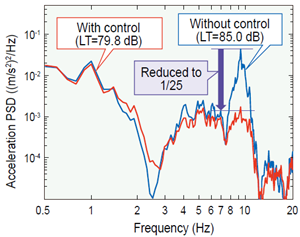25. Development of a Low-cost Primary and Secondary Vertical Semi-active Suspension System
In recent years, as ride comfort in the lateral direction of Shinkansen trains has improved, vertical vibrations have sometimes become more noticeable, creating a demand for effective countermeasures. In particular, vertical ride comfort on high-speed Shinkansen trains is affected not only by rigid-body vibrations, where the entire carbody moves as one unit, but also by elastic vibrations involving bending deformation of the car body, which differs from lateral vibrations.
At the Railway Technical Research Institute, we have proposed a vibration reduction control method that combines variable primary and secondary vertical dampers, both equipped with damping force control functions, to improve vertical ride comfort.
This system is designed to commercialize the above method by balancing vibration reduction performance with cost reduction. Specifically, for the two types of variable dampers, manufacturing costs were reduced by utilizing automotive parts and by decreasing the number of components and machining processes. Additionally, for the sensors that detect vehicle vibrations and are mounted on the bogie, we combined accelerometers and gyroscopes to reduce the number of sensor installation points from two to one per bogie, thereby lowering costs (Figure 1).
The system was installed on a vehicle, and vibration excitation tests simulating actual Shinkansen operation were conducted on a rolling stock test stand. As a result, the peak value of the vertical vibration acceleration PSD at the center of the carbody was reduced to 1/25 through control, achieving a maximum ride quality level (LT value) improvement of 5.2 dB (Figure 2).
This system is expected to be utilized as a low-cost solution for improving vertical ride comfort in Shinkansen trains operating at high speeds.


